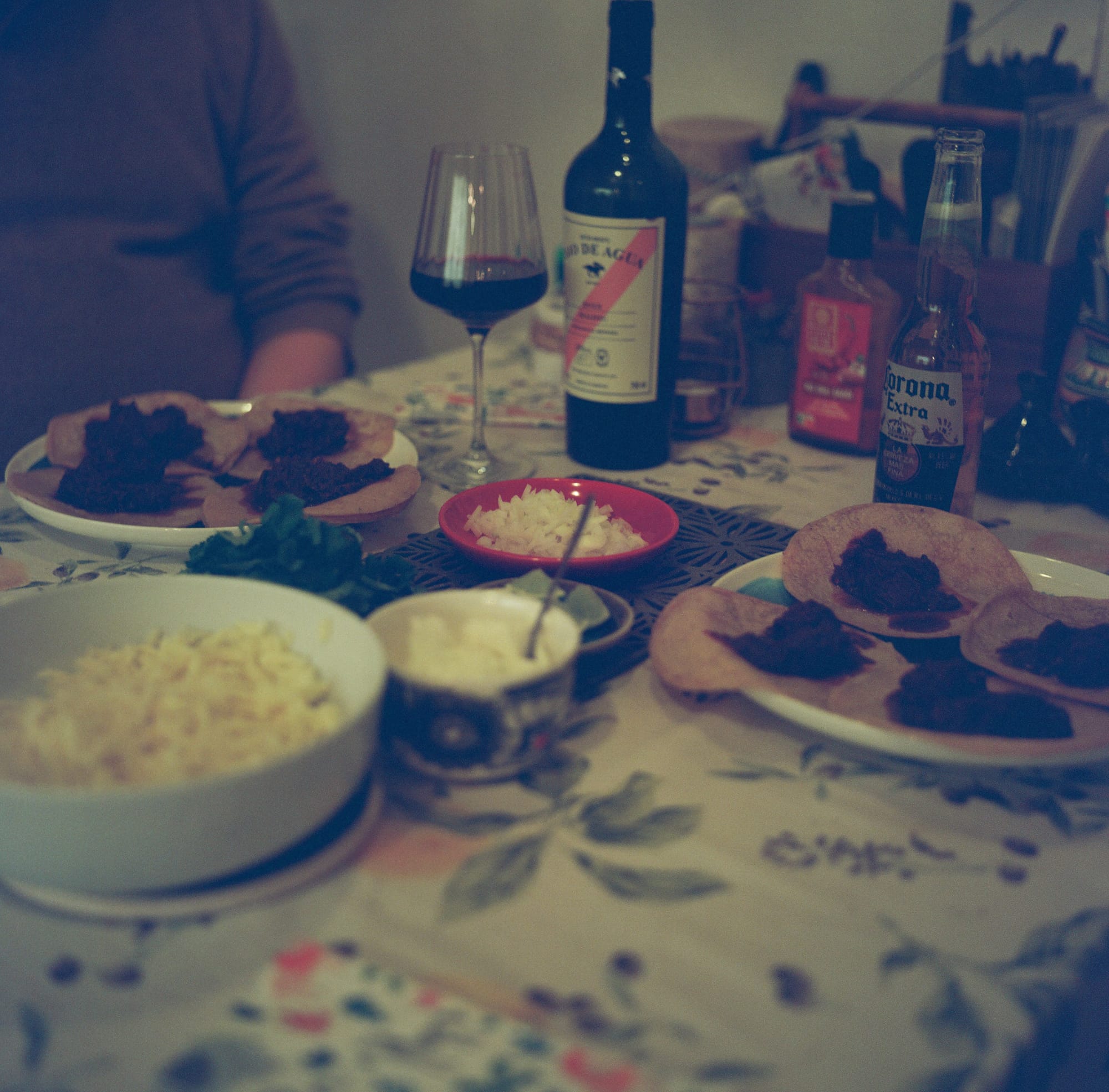What to eat MEXICO 🇲🇽 Tacos birria
The debate around the origins of the term taco in Mexico is very much alive and owes its existence to ambiguities around origins, and more finite power relationships of a dominant versus an indigenous culture.

Tacos birria
Published March 21, 2025 · by Amanda Rivkin Häsler
Tacos, the Mexican food, is just one of the many meanings of the word taco according to the Real Academia Española or the Royal Spanish Academy, publisher of the definitive dictionary of the Spanish language, as it is used in both Spain and the Americas. Other meanings include a wedge, a wad, a plug, a billiard cue, a blowpipe, a ramrod, a short or stocky person, and also a piece of wood. The word taco is Germanic in origin and has cognates in the French word tache and the English word “tack”. In Spain, there are also tacos de jamón, often big chunks of Spanish Iberian ham that are a wedge cut from a much bigger leg of jamón.
But what does this have to do with the Mexican food we know of as tacos, which by historical accounts pre-dates the arrival of the Spanish Conquistadors in Mexico? Well, it is one of two proposed etymological origins for the tacos we know of today, a dish whose true origin is obscured by legend and cultures that have been absorbed and subsumed by a dominant colonial presence.
Another possibility is the name is indigenous, coming from a Nahuatl word tlahco meaning “half” or “in the middle,” as in the food placed in the middle of the tortilla. This is also a possibility as dishes analogous to the modern taco existed in pre-Columbian societies. There is also evidence that the indigenous might be responsible for delivering us this wonderful dish despite being denied the credit in many contemporary circumstances. It is a story that repeats itself across all manner of life in the Americas, but when it comes to tacos there is also the Nahuatl word tlaxcalli which is a type of corn tortilla.

The debate around the origins of the term taco in Mexico is very much alive and owes its existence to ambiguities around origins, and more finite power relationships of a dominant versus an indigenous culture. Anthropological evidence suggests the indigenous living in the lake region of Valley of Mexico traditionally ate tacos with small fish.
Bernal Díaz del Castillo documented the first taco feast enjoyed by Europeans. It was a meal arranged by Hernán Cortés for his captains in Coyoacán, though it seems they did not refer to the dish they consumed as tacos, leaving open the possibility that while the food existed in some form, the naming convention did not arise until the nineteenth century. And it was not until 1891 that tacos are first mentioned in contemporary form in Manuel Payno’s novel, Los bandidos de Río-Frío.
So, what happened in between? Well, pre-Columbian societies thrived prior to the arrival of the Spanish with their own rich civilizations. These indigenous societies of the Americas grew and prospered apart from the Europeans who would begin to sail the world, initially due to the poor quality of local food and advances in astronomy, science and shipbuilding that coincided to deliver a way out of the Middle Ages and a time of flat earth theory.
While the initial conquistadores were authorized by the crown, usually Spanish or Portuguese and later British, largely due to proximity to the north Atlantic waters, later generations of immigrants to the new world included impoverished farmers and laborers looking for a new life and opportunities in the new world. By the nineteenth century, the legends of vast and undiscovered riches in the Americas had made their way back to Europe.

As laborers arrived and resources remained untapped, miners worked to excavate the riches of the land. This process required small amounts of dynamite that would jolt the earth into revealing what resources could be tapped. Using small charges of dynamite wrapped in small amounts of paper, the miners blasted their way through the earth using what they called simply tacos, making use of one of the many Spanish definitions on offer for this word.
These miners survived on a food they referred to as tacos sudados or tortillas with oil and stuffed with just a bit of potato to stay strong and fit throughout the work day. When the Mexican War of Independence began in 1810, many of these miners relocated to Mexico City. They brought with them their families and their food. In those days, the tacos we know today as tacos sudados or tacos de canasta, tacos filled with just a bit of stewed meat or fish or potatoes, were known in those days as tacos de minero or miners’ tacos. These were also the first street tacos in Mexico.
Other migrants have contributed mightily as well to the lore and deliciousness of this wonderful Mexican dish. Lebanese arrivals to Mexico in the twentieth century brought with them techniques for making shawarma, or spitfire roasted meats. Lovers of tacos al pastor might immediately recognize a shared technique, though with pork, and a bit of pineapple. Social media has given way to the cult of the tacos birria or birria tacos, which migrated from Jalisco state in Mexico to just about every state in the United States.
Indeed, food travels where people do. And whether it was pre-Colombian indigenous societies or miners in the nineteenth century, every population in Mexico’s past, present and likely future has left their indelible imprint on a dish so classic, it’s sure to top nearly every North American’s list of favorite foods. And with endless varieties, it’s possible to have the taco you want, how you want, ensuring that the future of this dish will tell us as much as its past.
Recipe
Ingredients:
7 guajillo chiles
5 mulato chiles
3 ancho chiles
2 onions
3 tomatoes
750 grams of beef chuck, roast, entrecote, shoulder, etc
Olive oil
Maldon salt
300 grams of water
4 cloves of garlic
1 cup beef broth
20 grams fresh oregano
1 teaspoon cumin
1 teaspoon cinnamon
1 teaspoon salt
2 black peppercorns
1 tablespoon apple cider vinegar
Step 1: Remove all the stems and seeds from the chiles. Set aside.
Step 2: Peel the onions and cut and half. Quarter the tomatoes. Cut the beef into two-inch cubes.
Step 3: In a pan, heat olive oil on a medium to high heat and add the beef and a pinch of salt over it. Turn until it is brown on all sides and remove from heat and turn down heat to low to medium high.
Step 4: Add onions, chiles and tomatoes to the pan along with water and stew until tomatoes and onions are soft, approximately 15-20 minutes.
Step 5: Move the ingredients in the sauce pan to a pan or bowl with tall sides. Add cloves of raw garlic, beef broth, oregano, cumin, cinnamon, salt, black peppercorns and vinegar. Combine with a handheld blender or in a blender until smooth.
Step 6: Return browned meat to sauce pan. Add blended sauce. Bring to a boil and then put on low heat and cover 1-2 hours until the beef is fork tender and ready to shred.
Step 7: Using two forks, shred the beef in the pan.
Step 8: Serve as tacos (or soup) on corn tortillas and top with cilantro and raw diced white onions and shredded cheese. In the absence of Oaxaca cheese, I use Turkish kasar cheese. You can also add crème fraiche, sour cream or Greek yogurt as desired or hot sauce and avocado, if desired. Tacos are so personal, so dress it how you love to eat it. For sides, rice and refried beans are nice, especially when added to caramelized onions and with extra hot pepper like powdered chipotle or jabanero pepper.
Tips, tricks and notes:
There is really only one place to get quality Mexican chiles and ingredients in Switzerland and that is El Maíz near the Zürich main rail station. They also have a website and do deliveries. The average large supermarket in Switzerland has a modest but pathetic Mexican food section for and by gringos. Avoid if possible and go to El Maíz for the real ingredients.
Learn where to eat Mexican food in Switzerland.
Follow our social media pages @swissglobaldining on Instagram, TikTok and YouTube